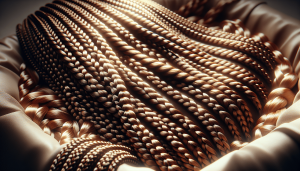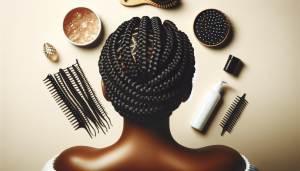Have you ever wondered about knotless feed-in braids and why they’re becoming such a popular choice among hairstyling techniques? If you’re considering trying this hairstyle or just looking to understand more about it, you’re in the right place. Knotless feed-in braids are not only trendy but also versatile and gentle on your hair, making them a worthy option for anyone looking to sport a chic and protective hairstyle. Curious about how to style knotless braids? There are countless ways to wear them, from sleek and straight to curly and textured. You can also experiment with different partings, lengths, and accessories to personalize your look. Whether you want to rock a half-up, half-down style or a high ponytail, knotless braids give you the freedom to express your individual style while keeping your hair healthy and protected.
What Are Knotless Feed-In Braids?
Knotless feed-in braids are a modern twist on traditional braids, eliminating the small knot often used at the base of standard braids. The technique involves weaving hair extensions into your natural hair seamlessly, leading to a beautiful and natural look without the tension typically associated with traditional braiding. This tension-free approach results in reduced stress on your scalp, which is particularly beneficial for those prone to hair-related headaches or scalp irritation.How Do Knotless Feed-In Braids Work?
In contrast to traditional braids where extensions are added at the starting point with a firm knot, knotless feed-in braids gradually incorporate extensions into your natural hair. This is done incrementally as the braiding progresses. This method allows the braids to lay flat against your scalp, creating a seamless and natural transition from your hair to the braid. Your hairdresser begins with your natural hair and slowly adds small pieces of synthetic hair to enhance thickness and length.Why Choose Knotless Feed-In Braids?
There are numerous reasons you might prefer knotless feed-in braids over other types of braids. Whether it’s for comfort, style, or hair health, this method offers several advantages.Benefits of Knotless Feed-In Braids
Scalp Health
Knotless feed-in braids minimize traction on your scalp. The gradual introduction of extensions means there’s less pulling and tension, which can prevent breakage and thinning edges. This makes them an excellent choice for sensitive scalps or those aiming to promote healthy hair growth.Natural Appearance
These braids boast a more natural appearance as there’s no discernible knot at the root. This can offer a flattering and aesthetically pleasing finish, making your braids look smooth and professional.Versatility
With knotless braids, you have the freedom to style your hair in numerous ways. Whether you want to leave them long, gather them into a high bun, or style them into an elaborate updo, the possibilities are nearly endless thanks to their flexibility.Longevity
While installation might take longer than traditional braids, the outcome is often longer-lasting. Proper maintenance can offer you weeks of beautiful hair without needing to worry about frequent retouches.Preparing for Knotless Feed-In Braids
Before you set out to get knotless braids, it’s important to prepare both your hair and yourself for the process. Proper preparation can make a significant difference in the outcome and longevity of your braids.Hair Preparation
Begin by washing and conditioning your hair to ensure it’s clean and free of product buildup. Deep conditioning can further help strengthen your hair shaft, preparing it for the braiding process. It’s also a good idea to detangle your hair thoroughly to prevent any pulling or discomfort during braiding.Finding a Qualified Stylist
Finding a skilled and experienced stylist is crucial to achieving beautiful knotless feed-in braids. Do some research, and consider checking reviews or asking for recommendations. It’s important to communicate openly with your stylist about your desired look and any concerns you might have regarding scalp sensitivity or hair health.The Installation Process
Understanding the steps involved in installing knotless feed-in braids can help you know what to expect, leading to a more relaxed experience.Step-by-Step Guide to Braiding
- Starting with Clean Hair: Ensuring your hair is freshly washed and conditioned provides a good base for braids.
- Parting the Hair: Your stylist will section your hair into desired partings, considering your preferred braid size and style.
- Beginning the Braid: The braid begins with your natural hair, creating a tight grip at the start without using extensions.
- Adding Extensions Gradually: Once the initial braid is established, extensions are gradually added, ensuring a seamless integration.
- Securing the End: As each braid is completed, it’s tightly secured to prevent unraveling, usually with the help of warm water or hair spray.
Time Considerations
The process of installing knotless braids can take several hours, ranging from 4 to 8, depending on the size and length of the braids you prefer. While this might seem lengthy, it’s a worthwhile investment for the style and comfort you’ll enjoy afterward.Maintenance and Care Tips
Once your knotless feed-in braids are installed, maintaining them is crucial for keeping them looking fresh and neat. Proper care can extend the life of your braids and prevent damage to your natural hair.Night Care Routine
At night, wrap your braids in a silk or satin scarf to reduce friction while sleeping. This simple step helps maintain the neatness of your braids and reduces frizz.Washing Your Braids
You can wash your scalp with a diluted shampoo every few weeks to remove sweat and product buildup. Use your fingertips to gently apply the shampoo and rinse with care. Follow up with a light application of conditioner on your scalp and rinse thoroughly.Moisturizing the Scalp
Keeping your scalp hydrated is vital. Consider using a light oil or braid spray to moisturize without weighing down the braids. Massage the product into your scalp for even distribution and relief from dryness.Styling Options
Feel free to experiment with different styles, but avoid excessive manipulation. Tying your braids into different styles adds versatility to your look, but be careful not to apply too much tension that might damage your hair.Troubleshooting Common Issues
Even with the best care, you might face some challenges with your knotless feed-in braids. Here’s how to tackle common problems that may arise.Itchy Scalp
If you experience an itchy scalp, it’s often due to dryness or product buildup. Ensure you’re keeping your scalp moisturized and clean, and consider using a braid-specific spray or oil.Frizz and Unraveling
Frizz is typically a natural development as your braids age. Light application of gel or mousse can help smoothen the frizz. In cases where braids start to unravel, you might need to visit your stylist for a quick fix.Maintaining Edges
Your edges can be a vulnerable part of your hair. Consider using edge control products to maintain your hairline without causing damage. Be gentle and avoid excessive styling on the edges.Removing Knotless Feed-In Braids
When it’s time to remove your braids, it’s essential to do so carefully to prevent any damage to your natural hair.Removal Steps
- Cut and Unravel: Before you start, cut the extensions a few inches below your natural hair to make the process easier. Unravel the braids gently starting from the bottom.
- Detangle with Care: After the extensions are removed, your hair may be tangled. Use a wide-tooth comb to detangle gently, starting from the ends and working your way to the roots.
- Wash and Condition: Once detangled, wash your hair thoroughly to remove any product residue, and follow up with a deep conditioning treatment to restore moisture.
Cost Considerations
The cost of installing knotless feed-in braids can vary widely based on several factors.Factors Affecting Cost
- Location: The price may differ depending on where you live. Bigger cities might have higher costs due to increased demand and the cost of living.
- Stylist Experience: Experienced stylists may charge more, but their expertise can ensure a higher quality result.
- Braid Size and Length: Smaller and longer braids typically require more time and, therefore, may cost more.
Average Price Range
On average, knotless feed-in braids can range from $150 to $600. Keep in mind that investing in a good quality installation and aftercare can enhance the longevity and beauty of your braids.What Are the Benefits of Knotless Feed-In Braids?
Knotless feed-in braids have garnered attention for being gentler on the scalp and reducing tension. One of the burning questions about knotless braids is whether they can promote hair growth. Additionally, these braids are known for their sleek and natural appearance, making them a popular choice for many.



